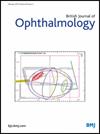60-100岁老年人年龄相关性黄斑变性对视力相关生活质量的影响:一项横断面研究
IF 3.7
2区 医学
Q1 OPHTHALMOLOGY
引用次数: 0
摘要
本研究评估了亚洲老年人年龄相关性黄斑变性(AMD)的患病率及其与年龄的相互作用对视力相关生活质量(VRQoL)的影响。方法:我们从2017-2022年新加坡老年人人口健康和眼病概况横断面研究中纳入了2361名年龄在60-101岁之间的参与者。早期和晚期AMD采用改进的威斯康星分级系统进行分级。VRQoL采用Rasch-transformed overall、视觉功能和情绪幸福感量表进行评估。我们计算了AMD的患病率,并使用多变量回归模型来评估AMD与VRQoL年龄之间的关系。如果VRQoL基线评分的SD值≥0.5,则认为VRQoL降低具有临床意义。结果任意期、早期和晚期AMD的总体患病率分别为6.2%、4.4%和1.8%。年龄特异性患病率随着年龄的增长而逐渐增加;也就是说,在三个年龄组(60-79岁,70-79岁和80岁以上)中,任何AMD(4.1%, 7.2%, 12.9%),早期AMD(3.0%, 4.7%, 9.3%)和晚期AMD(1.1%, 2.5%, 3.5%)。与没有AMD的60-79岁患者相比,年龄≥80岁晚期AMD患者的总体、视觉功能和情绪幸福感分别差30.1%、21.0%和29.7%(均p≤0.001)。重要的是,只有年龄≥80岁的晚期AMD患者的VRQoL有统计学意义和临床意义。结论AMD在亚洲老年人中普遍存在,对视觉功能和情绪健康有重大影响。我们的研究结果支持早期发现视觉功能和心理健康下降,以及预防老年患者发展为晚期AMD的策略。如有合理要求,可提供资料。本文章由计算机程序翻译,如有差异,请以英文原文为准。
Vision-related quality of life impact of age-related macular degeneration in older adults aged 60–100 years: a cross-sectional study
Background We evaluated the prevalence of age-related macular degeneration (AMD) and its interplay with age in influencing vision-related quality of life (VRQoL) in older Asians. Methods We included 2361 participants aged 60–101 years from the Population Health and Eye Disease Profile in Elderly Singaporeans cross-sectional study (2017–2022). Early and late AMD were graded using the modified Wisconsin grading system. VRQoL was assessed using Rasch-transformed overall, visual functioning and emotional well-being scores of the Brief Impact of Visual Impairment questionnaire. We calculated the prevalence of AMD and used multivariable regression models to assess the associations between AMD and age on VRQoL. VRQoL reduction was deemed clinically meaningful if ≥0.5 SD of the cohort’s baseline VRQoL scores. Results The overall prevalence of any, early and late AMD was 6.2%, 4.4% and 1.8%, respectively. The age-specific prevalence increased progressively with age; that is, any AMD (4.1%, 7.2%, 12.9%), early AMD (3.0%, 4.7%, 9.3%) and late AMD (1.1%, 2.5%, 3.5%) across the three age groups (60–79, 70–79 and 80+), respectively. Participants aged ≥80 with late AMD experienced 30.1%, 21.0% and 29.7% poorer overall, visual functioning and emotional well-being, respectively (all p≤0.001), compared with those aged 60–79 without AMD. Importantly, only those aged ≥80 with late AMD demonstrated both statistically and clinically meaningful VRQoL reductions. Conclusions AMD is prevalent in ageing Asians and has a substantial impact on visual functioning and emotional well-being. Our findings support early detection of declining visual functioning and mental health and strategies to prevent progression to late-stage AMD in older patients. Data are available upon reasonable request.
求助全文
通过发布文献求助,成功后即可免费获取论文全文。
去求助
来源期刊
CiteScore
10.30
自引率
2.40%
发文量
213
审稿时长
3-6 weeks
期刊介绍:
The British Journal of Ophthalmology (BJO) is an international peer-reviewed journal for ophthalmologists and visual science specialists. BJO publishes clinical investigations, clinical observations, and clinically relevant laboratory investigations related to ophthalmology. It also provides major reviews and also publishes manuscripts covering regional issues in a global context.

 求助内容:
求助内容: 应助结果提醒方式:
应助结果提醒方式:


